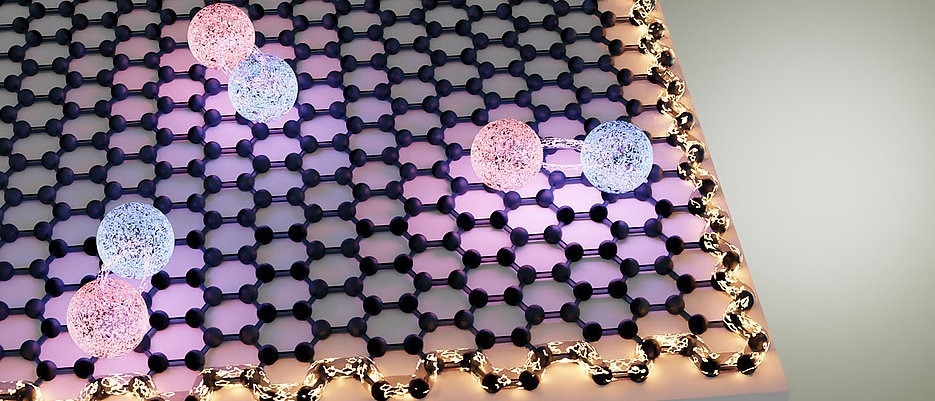In the framework of the Würzburg-Dresden Cluster of Excellence ct.qmat, excitons were produced in a topological insulator initially. This is a discovery in quantum research, depending on a material design from Würzburg.

Three excitons (pairs consisting of an electron and an electron hole) on the topological insulator bismuthene. Due to the honeycomb atomic structure, electrons can only flow along the edges. Image Credit: Pawel Holewa
An international research group collaborating within the Würzburg-Dresden Cluster of Excellence ct.qmat has achieved a discovery in quantum research. It is known to be the first detection of excitons (electrically neutral quasiparticles) present in a topological insulator.
This breakthrough sets the stage for a new generation of light-driven computer chips and quantum technologies. It was possible as a result of the smart material design in Würzburg, which is known to be the birthplace of topological insulators. The study outcomes have been reported in the Nature Communications journal.
New Toolbox for Solid State Physics
In their hunt for novel materials for quantum technologies in the future, one area that researchers from the Cluster of Excellence ct.qmat—Complexity and Topology in Quantum Matter—at the two universities in Würzburg and Dresden are focusing on is topological insulators.
The first experimental realization of this materials class happened in Würzburg in 2007, leading to a global research boom in solid-state physics that remains until this day.
Earlier concepts for making use of topological insulators relied on the application of electrical voltages to control currents. It is a method adopted from traditional computer chips.
However, if the exotic material properties are dependent on electrically neutral particles (which are neither positively nor negatively charged), an electric voltage does not work anymore. Hence, such quantum phenomena need other tools if they are to be produced at all—for instance, light.
Optics and Electronics are Linked by a Quantum Phenomenon
At present, a vital breakthrough has been made by an international research group directed by Professor Ralph Claessen, quantum physicist from Würzburg and co-spokesperson of ct.qmat.
For the first time, we’ve been able to generate and experimentally detect quasiparticles known as excitons in a topological insulator. We’ve thus created a new toolkit for solid-state physics that can be used to control electrons optically. This principle could become the basis for a new type of electronic components.
Ralph Claessen, Professor and Quantum Physicist, Julius-Maximilians-Universitat Würzburg
Excitons are defined as electronic quasiparticles. Even though they seem to act like separate particles, they indeed constitute an excited electronic state that could only be generated in a few kinds of quantum matter.
We created excitons by applying a short light pulse to a thin film consisting of just one single layer of atoms. This has opened up a completely new line of research for topological insulators.
Ralph Claessen, Professor and Quantum Physicist, Julius-Maximilians-Universitat Würzburg
Claessen states that what is strange about this is that the excitons were triggered in a topological insulator—something that was not made possible before.
For nearly ten years, excitons have been examined in other two-dimensional semiconductors and viewed as information carriers for light-driven components.
For the first time, we’ve managed to optically excite excitons in a topological insulator. The interaction between light and excitons means we can expect new phenomena in such materials. This principle could be used, for example, to generate qubits.
Ralph Claessen, Professor and Quantum Physicist, Julius-Maximilians-Universitat Würzburg
Qubits are computing units for quantum chips. They are substantially greater than conventional bits and enable the resolution of tasks within minutes, which conventional supercomputers would take years to do.
Making use of light rather than electrical voltage allows quantum chips to have much quicker processing speeds. Hence, the new findings set the stage for future quantum technologies and a new generation of light-driven devices in the field of microelectronics.
Global Expertise from Würzburg
The right starting material is vital—in this case, bismuthene.
“It’s the heavy sibling of the miracle material graphene,” states Claessen, who initially customized the topological insulator in the laboratory five years ago. “We’re the global leaders in this field.”
Claessen added, “Due to our sophisticated materials design, the atoms of the single layer of bismuthene are arranged in a honeycomb pattern, just like graphene. The difference is that bismuthene’s heavy atoms make it a topological insulator, meaning it can conduct electricity along the edge without loss—even at room temperature. This can’t be done by graphene.”
Huge Potential
Since the research group has generated excitons in a topological insulator for the first time, huge attention is being applied to the quasiparticles themselves. Researchers at ct.qmat are analyzing whether the topological properties of bismuthine have been transferred to excitons.
Demonstrating this in a scientific manner is the next milestone that scientists have set their sights on. Also, it would set the stage for the construction of topological qubits, which are considered specifically powerful than their non-topological counterparts.
International Cooperation
These outcomes are a result of a close partnership between researchers from Bologna, Wroclaw, New York, Oldenburg, and Würzburg. At the JMU Würzburg, the 2D material samples of bismuthene were produced.
Journal Reference:
Syperek, M., et al. (2022) Observation of room temperature excitons in an atomically thin topological insulator. Nature communications. doi.org/10.1038/s41467-022-33822-8.